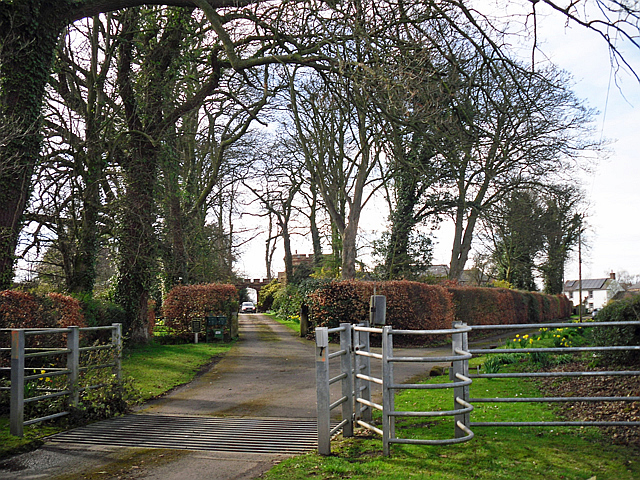|
Cardew Lodge
Cardew Lodge is a country house at Cardew near Thursby in Cumbria. It is a Grade II listed building. History The house was built as a hunting lodge for Major-General William Henry Lowther following his retirement from the Bengal Army in the late 1870s. The house has "single-storey gabled wings reminiscent of an Indian bungalow, which he stuffed with mementos of his time in Bengal, including the skin of a crocodile shot after it had eaten a man, and he planted rhododendrons and azaleas in his garden." The house was acquired by C. J. Ferguson, an architect, who designed and commissioned additions in 1889. In addition to the turreted tower which is built into the house, it has twin towers on the drive up to the house. It became the retirement home of Barbara Dunn, the first British licensed radio operator, after the Second World War World War II or the Second World War, often abbreviated as WWII or WW2, was a world war that lasted from 1939 to 1945. It involved the ... [...More Info...] [...Related Items...] OR: [Wikipedia] [Google] [Baidu] |
Cattle Grid On Road Approaching Cardew Lodge
Cattle (''Bos taurus'') are large, domesticated, cloven-hooved, herbivores. They are a prominent modern member of the subfamily Bovinae and the most widespread species of the genus ''Bos''. Adult females are referred to as cows and adult males are referred to as bulls. Cattle are commonly raised as livestock for meat (beef or veal, see beef cattle), for milk (see dairy cattle), and for hides, which are used to make leather. They are used as riding animals and draft animals ( oxen or bullocks, which pull carts, plows and other implements). Another product of cattle is their dung, which can be used to create manure or fuel. In some regions, such as parts of India, cattle have significant religious significance. Cattle, mostly small breeds such as the Miniature Zebu, are also kept as pets. Different types of cattle are common to different geographic areas. Taurine cattle are found primarily in Europe and temperate areas of Asia, the Americas, and Australia. Zebus (also cal ... [...More Info...] [...Related Items...] OR: [Wikipedia] [Google] [Baidu] |
Cardew, Cumbria
Cardew is a hamlet in Cumbria, England. It is located southwest of Dalston, south of Cardewlees and east of Thursby. Cardew House, a 16th-century farmhouse built for the Denton family, is a country house of note and Cardew Lodge, a hunting lodge built for Major General William Henry Lowther, is a country house built in the style of an Indian bungalow. See also *List of places in Cumbria This is a list of cities, towns and villages in the county of Cumbria, England. A * Abbeytown, Ackenthwaite, Adgarley, Aglionby *Aiketgate, Aikhead, Aikshaw, Aikton, Ainstable, Aisgill * Albyfield, Aldingham, A ... References Hamlets in Cumbria Dalston, Cumbria {{Cumbria-geo-stub ... [...More Info...] [...Related Items...] OR: [Wikipedia] [Google] [Baidu] |
Thursby
Thursby is a village in the Allerdale borough of Cumbria, England. It is near to the city of Carlisle in North West England. Thursby was historically part of Cumberland. History Thursby lies on an old Roman road, 6 miles south of Carlisle. Thursby takes its old name 'Thor's by' from Thor, the Thunder God of the Saxons, whose temple was reputedly nearby at Kirksteads. The village is predominantly centred on the church, a Victorian building built in 1846 and funded by the Brisco family of Crofton Hall. A bit of heritage comes to Thursby with the church reportedly have been built by King David I of Scotland. Thursby has always been known as a commuter village for travellers to pass through. The Romans once passed through Thursby on their way to Carlisle. However today the village is predominately a bedroom community for the city nearby – the village is closely linked. Thursby continues to thrive and grow with active community groups and regular events occurring at the parish ... [...More Info...] [...Related Items...] OR: [Wikipedia] [Google] [Baidu] |
Cumbria
Cumbria ( ) is a ceremonial and non-metropolitan county in North West England, bordering Scotland. The county and Cumbria County Council, its local government, came into existence in 1974 after the passage of the Local Government Act 1972. Cumbria's county town is Carlisle, in the north of the county. Other major settlements include Barrow-in-Furness, Kendal, Whitehaven and Workington. The administrative county of Cumbria consists of six districts (Allerdale, Barrow-in-Furness, Carlisle, Copeland, Eden and South Lakeland) and, in 2019, had a population of 500,012. Cumbria is one of the most sparsely populated counties in England, with 73.4 people per km2 (190/sq mi). On 1 April 2023, the administrative county of Cumbria will be abolished and replaced with two new unitary authorities: Westmorland and Furness (Barrow-in-Furness, Eden, South Lakeland) and Cumberland (Allerdale, Carlisle, Copeland). Cumbria is the third largest ceremonial county in England by area. It is ... [...More Info...] [...Related Items...] OR: [Wikipedia] [Google] [Baidu] |
Listed Building
In the United Kingdom, a listed building or listed structure is one that has been placed on one of the four statutory lists maintained by Historic England in England, Historic Environment Scotland in Scotland, in Wales, and the Northern Ireland Environment Agency in Northern Ireland. The term has also been used in the Republic of Ireland, where buildings are protected under the Planning and Development Act 2000. The statutory term in Ireland is "protected structure". A listed building may not be demolished, extended, or altered without special permission from the local planning authority, which typically consults the relevant central government agency, particularly for significant alterations to the more notable listed buildings. In England and Wales, a national amenity society must be notified of any work to a listed building which involves any element of demolition. Exemption from secular listed building control is provided for some buildings in current use for worsh ... [...More Info...] [...Related Items...] OR: [Wikipedia] [Google] [Baidu] |
Bengal Army
The Bengal Army was the army of the Bengal Presidency, one of the three presidencies of British India within the British Empire. The presidency armies, like the presidencies themselves, belonged to the East India Company (EIC) until the Government of India Act 1858 (passed in the aftermath of the Indian Rebellion of 1857) transferred all three presidencies to the direct authority of the British Crown. In 1895 all three presidency armies were merged into the Indian Army. History Origins The Bengal Army originated with the establishment of a European Regiment in 1756. While the East India Company had previously maintained a small force of Dutch and Eurasian mercenaries in Bengal, this was destroyed when Calcutta was captured by the Nawab of Bengal on 30 June that year. Under East India Company In 1757 the first locally recruited unit of Bengal sepoys was created in the form of the ''Lal Paltan'' battalion. It was recruited from soldiers that had served in the Nawab's Army ... [...More Info...] [...Related Items...] OR: [Wikipedia] [Google] [Baidu] |
Charles John Ferguson
Charles John Ferguson (usually known as C. J. Ferguson) (1840 – 1 December 1904) was an English architect who practised mainly in Carlisle, Cumbria, Carlisle, Cumbria. He was the younger son of Joseph Ferguson of Carlisle, and was Articled clerk, articled to the architect and surveyor John A. Cory. He spent some years in partnership with Cory, but most of his career was in single-handed practice. From about 1902 he also had an office in London. Ferguson's output included new churches, Victorian restoration, restoration of existing churches, and work on English country house, country houses and public buildings. The architectural styles he used were mainly Gothic Revival architecture, Gothic and Romanesque Revival architecture, Norman Revival. Almost all his works are in what is now Cumbria, with a few isolated commissions elsewhere. The latter were obtained through personal contacts, for example his work for William Armstrong, 1st Baron Armstrong, William Armstrong ... [...More Info...] [...Related Items...] OR: [Wikipedia] [Google] [Baidu] |
Turret (architecture)
In architecture, a turret is a small tower that projects vertically from the wall of a building such as a medieval castle. Turrets were used to provide a projecting defensive position allowing covering fire to the adjacent wall in the days of military fortification. As their military use faded, turrets were used for decorative purposes, as in the Scottish baronial style. A turret can have a circular top with crenellations as seen in the picture at right, a pointed roof, or other kind of apex. It might contain a staircase if it projects higher than the building; however, a turret is not necessarily higher than the rest of the building; in this case, it is typically part of a room, that can be simply walked into – see the turret of Chateau de Chaumont on the collection of turrets, which also illustrates a turret on a modern skyscraper. A building may have both towers and turrets; towers might be smaller or higher, but turrets instead project from the edge of a buildin ... [...More Info...] [...Related Items...] OR: [Wikipedia] [Google] [Baidu] |
Amateur Radio Operator
An amateur radio operator is someone who uses equipment at an amateur radio station to engage in two-way personal communications with other amateur operators on radio frequencies assigned to the amateur radio service. Amateur radio operators have been granted an amateur radio license by a governmental regulatory authority after passing an examination on applicable regulations, electronics, radio theory, and radio operation. As a component of their license, amateur radio operators are assigned a call sign that they use to identify themselves during communication. About three million amateur radio operators are currently active worldwide. Amateur radio operators are also known as radio amateurs or hams. The term "ham" as a nickname for amateur radio operators originated in a pejorative usage (like "ham actor") by operators in commercial and professional radio communities, and dates to wired telegraphy. The word was subsequently adopted by amateur radio operators. Demographics ... [...More Info...] [...Related Items...] OR: [Wikipedia] [Google] [Baidu] |
World War II
World War II or the Second World War, often abbreviated as WWII or WW2, was a world war that lasted from 1939 to 1945. It involved the World War II by country, vast majority of the world's countries—including all of the great powers—forming two opposing military alliances: the Allies of World War II, Allies and the Axis powers. World War II was a total war that directly involved more than 100 million Military personnel, personnel from more than 30 countries. The major participants in the war threw their entire economic, industrial, and scientific capabilities behind the war effort, blurring the distinction between civilian and military resources. Air warfare of World War II, Aircraft played a major role in the conflict, enabling the strategic bombing of population centres and deploying the Atomic bombings of Hiroshima and Nagasaki, only two nuclear weapons ever used in war. World War II was by far the List of wars by death toll, deadliest conflict in hu ... [...More Info...] [...Related Items...] OR: [Wikipedia] [Google] [Baidu] |
Country Houses In Cumbria
A country is a distinct part of the world, such as a state, nation, or other political entity. It may be a sovereign state or make up one part of a larger state. For example, the country of Japan is an independent, sovereign state, while the country of Wales is a component of a multi-part sovereign state, the United Kingdom. A country may be a historically sovereign area (such as Korea), a currently sovereign territory with a unified government (such as Senegal), or a non-sovereign geographic region associated with certain distinct political, ethnic, or cultural characteristics (such as the Basque Country). The definition and usage of the word "country" is flexible and has changed over time. ''The Economist'' wrote in 2010 that "any attempt to find a clear definition of a country soon runs into a thicket of exceptions and anomalies." Most sovereign states, but not all countries, are members of the United Nations. The largest country by area is Russia, while the smallest is ... [...More Info...] [...Related Items...] OR: [Wikipedia] [Google] [Baidu] |
Grade II Listed Houses
Grade most commonly refers to: * Grade (education), a measurement of a student's performance * Grade, the number of the year a student has reached in a given educational stage * Grade (slope), the steepness of a slope Grade or grading may also refer to: Music * Grade (music), a formally assessed level of profiency in a musical instrument * Grade (band), punk rock band * Grades (producer), British electronic dance music producer and DJ Science and technology Biology and medicine * Grading (tumors), a measure of the aggressiveness of a tumor in medicine * The Grading of Recommendations Assessment, Development and Evaluation (GRADE) approach * Evolutionary grade, a paraphyletic group of organisms Geology * Graded bedding, a description of the variation in grain size through a bed in a sedimentary rock * Metamorphic grade, an indicatation of the degree of metamorphism of rocks * Ore grade, a measure that describes the concentration of a valuable natural material in the surr ... [...More Info...] [...Related Items...] OR: [Wikipedia] [Google] [Baidu] |





.jpg)



